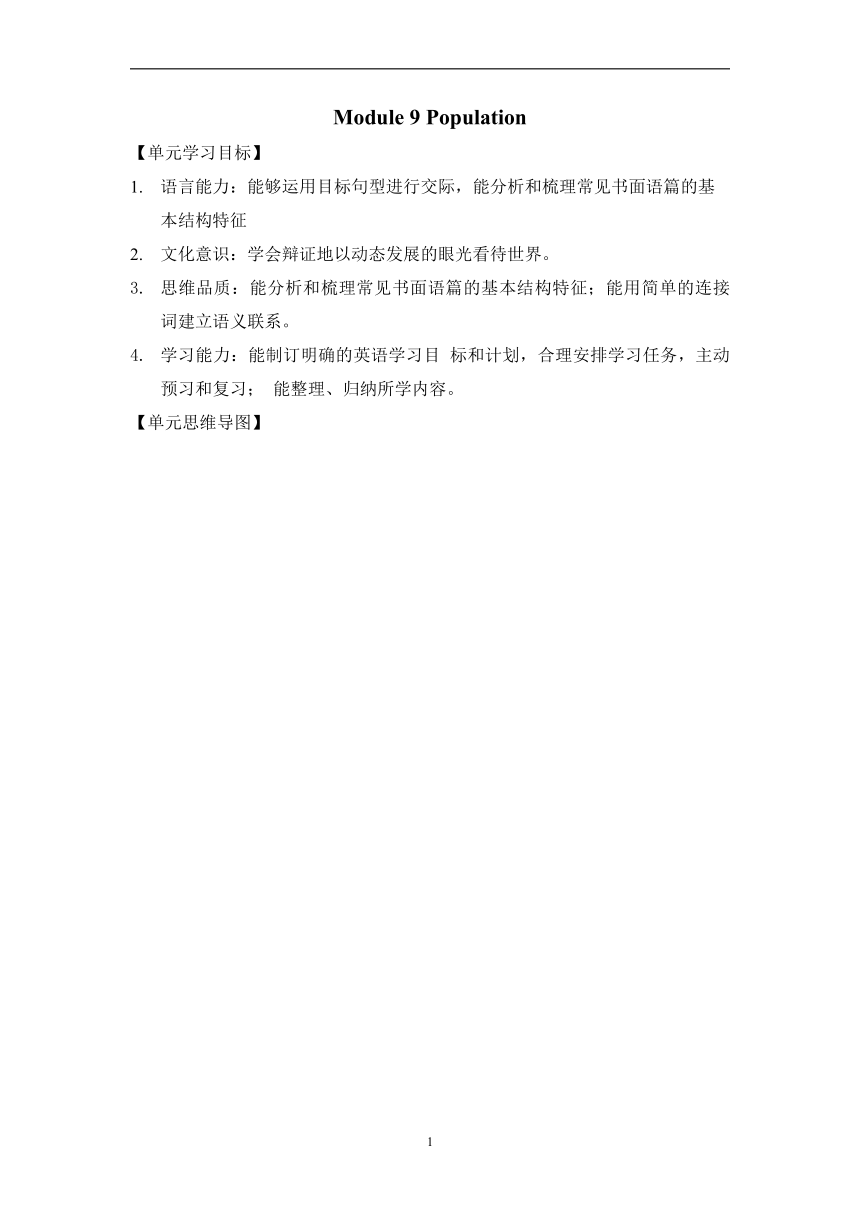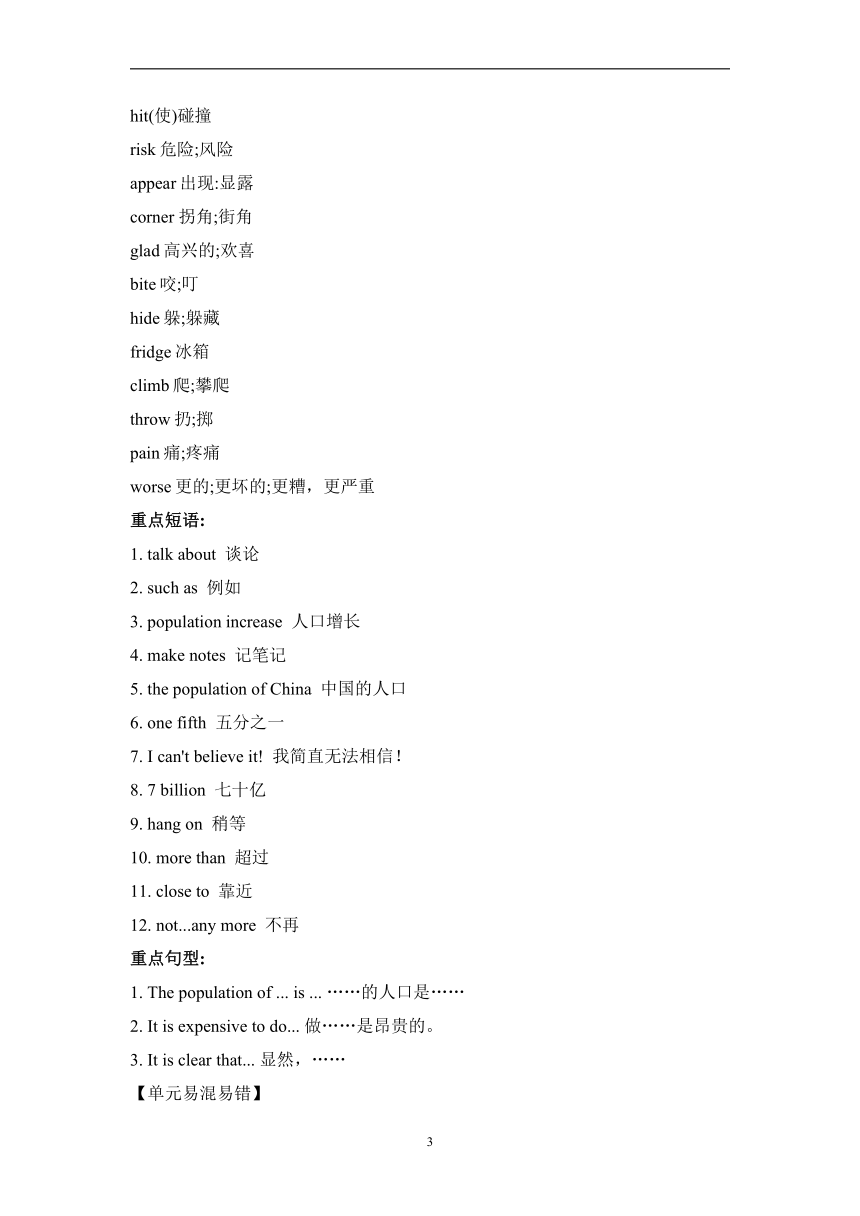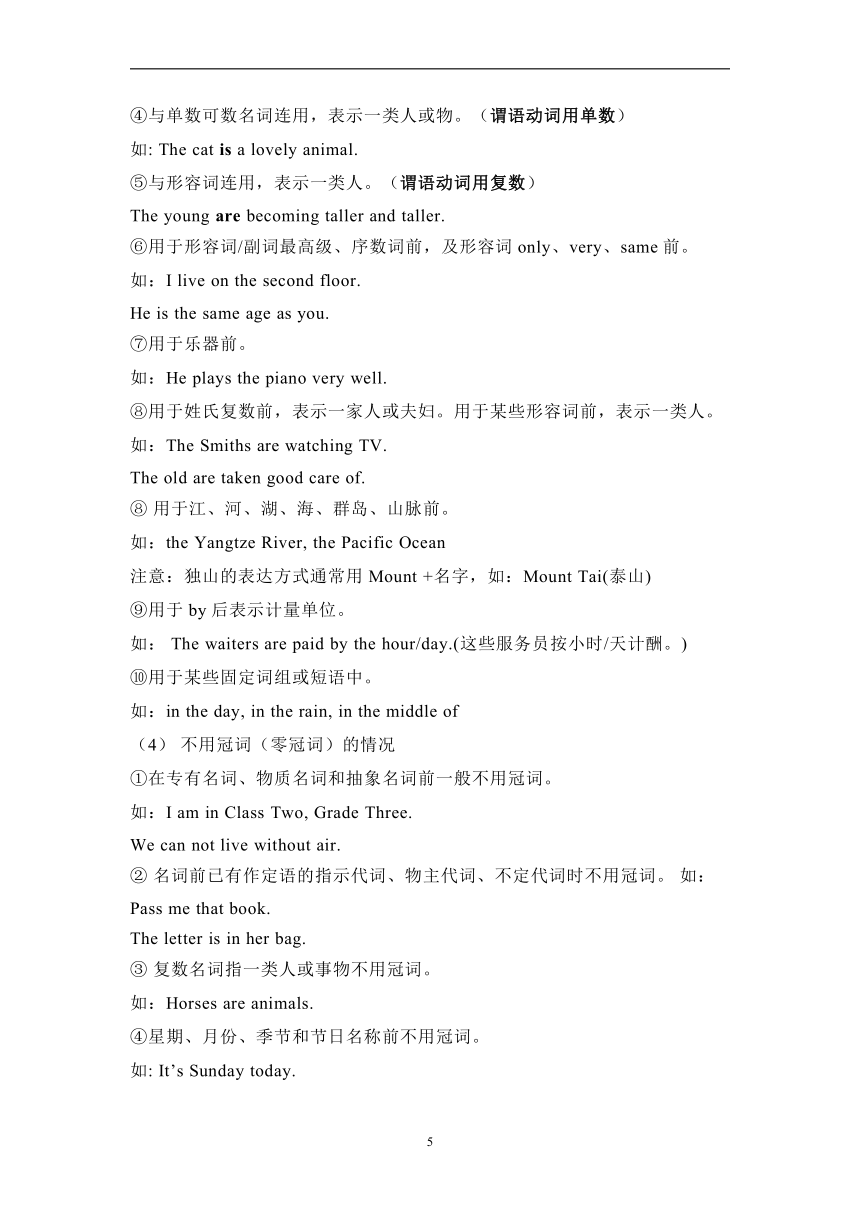Module 9 Population—2023-2024学年外研版英语八年级上册单元知识链接(含解析)
文档属性
| 名称 | Module 9 Population—2023-2024学年外研版英语八年级上册单元知识链接(含解析) |  | |
| 格式 | docx | ||
| 文件大小 | 132.7KB | ||
| 资源类型 | 教案 | ||
| 版本资源 | 外研版 | ||
| 科目 | 英语 | ||
| 更新时间 | 2023-10-27 16:02:32 | ||
图片预览





文档简介
Module 9 Population
【单元学习目标】
语言能力:能够运用目标句型进行交际,能分析和梳理常见书面语篇的基本结构特征
文化意识:学会辩证地以动态发展的眼光看待世界。
思维品质:能分析和梳理常见书面语篇的基本结构特征;能用简单的连接词建立语义联系。
学习能力:能制订明确的英语学习目 标和计划,合理安排学习任务,主动预习和复习; 能整理、归纳所学内容。
【单元思维导图】
【单元知识梳理】
重点单词:
pale (肤色)苍白的
round转到(某物的)另一边
hit(使)碰撞
risk危险;风险
appear出现:显露
corner 拐角;街角
glad高兴的;欢喜
bite咬;叮
hide躲;躲藏
fridge冰箱
climb爬;攀爬
throw扔;掷
pain痛;疼痛
worse更的;更坏的;更糟,更严重
重点短语:
1. talk about 谈论
2. such as 例如
3. population increase 人口增长
4. make notes 记笔记
5. the population of China 中国的人口
6. one fifth 五分之一
7. I can't believe it! 我简直无法相信!
8. 7 billion 七十亿
9. hang on 稍等
10. more than 超过
11. close to 靠近
12. not...any more 不再
重点句型:
1. The population of ... is ... ……的人口是……
2. It is expensive to do... 做……是昂贵的。
3. It is clear that... 显然,……
【单元易混易错】
冠词和数词
1.冠词
(1)定义:冠词是虚词,本身不能单独使用,也没有词义,它用在名词的前面,帮助指明名词的含义。英语中的冠词有三种:定冠词、不定冠词、零冠词。
类别 形式 用法概述
不定冠词 a 表示泛指,意义同one 用于以辅音发音开头的单词或字母前
an 用于以元音发音开头的单词或字母前
定冠词 the 表示特指,其意义同this/that/these/those
注意:用a还是用an取决于单词的第一个发音,而不是字母。如: an hour, a university
(2)不定冠词的用法
①表示初次提到的人或物。
如: A boy is waiting for you.
② 表示一类人或物
如:A horse is an animal.
③用于某些固定词组或短语中。
如:a little, a few, a lot, many a, in a minute, have a cold, all of a sudden(突然)
(3)定冠词的用法
①表示上文提到过的人或事物。
如: I saw a boy yesterday. The boy was very tall.
②特指双方都明白的人或物。
如: Open the door, please.
Give me the book.
③指世上独一无二的事物前。
如:The sun is bigger than the earth.
④与单数可数名词连用,表示一类人或物。(谓语动词用单数)
如: The cat is a lovely animal.
⑤与形容词连用,表示一类人。(谓语动词用复数)
The young are becoming taller and taller.
⑥用于形容词/副词最高级、序数词前,及形容词only、very、same前。
如:I live on the second floor.
He is the same age as you.
⑦用于乐器前。
如:He plays the piano very well.
⑧用于姓氏复数前,表示一家人或夫妇。用于某些形容词前,表示一类人。
如:The Smiths are watching TV.
The old are taken good care of.
⑧ 用于江、河、湖、海、群岛、山脉前。
如:the Yangtze River, the Pacific Ocean
注意:独山的表达方式通常用Mount +名字,如:Mount Tai(泰山)
⑨用于by后表示计量单位。
如: The waiters are paid by the hour/day.(这些服务员按小时/天计酬。)
⑩用于某些固定词组或短语中。
如:in the day, in the rain, in the middle of
(4) 不用冠词(零冠词)的情况
①在专有名词、物质名词和抽象名词前一般不用冠词。
如:I am in Class Two, Grade Three.
We can not live without air.
② 名词前已有作定语的指示代词、物主代词、不定代词时不用冠词。 如: Pass me that book.
The letter is in her bag.
③ 复数名词指一类人或事物不用冠词。
如:Horses are animals.
④星期、月份、季节和节日名称前不用冠词。
如: It’s Sunday today.
⑤三餐、球类、学科名词之前不用冠词。
如:When do you have lunch
He often plays football.
⑥由介词by引导的交通工具名词前不用冠词。
We traveled by train.
⑦在称呼语或表示头衔的名词前不加冠词。
如:Miss Li, Professor Chen
⑧两个相同及相对的名词并用时不加冠词。
如:face to face, day and night, father and son, side by side
⑨某些固定词组或习惯用语中不用冠词。
如: at night, go to school, by bus, on foot, at home, at work, in trouble, in line,
at school, at noon, in time, in English, on time, for example
(5)冠词对意义的影响
英语中有一些词组,用the不用the,其含义和用法大相径庭。
如:in hospital(生病住院), in the hospital(在医院里做其他事),
at table(在吃饭), at the table(在桌子旁),
in class(在上课), in the class(在教室里),
go to church(去教堂做礼拜), go to the church(去教堂做某他的事), three of us(我们中的三个), the three of us(我们三个),
in front of(在前面), in the front of(在某物内部的前面)
数词
2.数词
(1)定义:数词分为基数词和序数词。基数词表示数目的多少;序数词表示数目的顺序,其前通常加定冠词the。
(2)基数词的构成
① 1-12为独立的单数。
如:one, two, three, four, five, six, seven, eight, nine, ten, eleven, twelve
②13~19的基数词以-teen结尾。
如:thirteen, fourteen, fifteen, sixteen, seventeen, eighteen, nineteen
③ 20~90整十位的基数词以-ty结尾。
如:twenty, thirty, forty, fifty, sixty, seventy, eighty, ninety。
④“几十几”由十位数和个位数之间加连字符“-”构成。
如:36→thirty-six;58→fifty-eight;
⑤ 101~999的基数词由百位数后加and,再加十位数或个位数构成。
如: 365→three hundred and sixty-five
⑥ 1000以上基数词的表示方法:从右向左用分节号“,”分节,每三个数字为一节,第一个分节号前用thousand,第二个分节号前用million,第三个分节号前用billion。
如:2,418,000,000→two billion, four hundred and eighteen million
⑦hundred, thousand, million, billion等的用法
前面有数字,后面不加“s”,不加“of”
如:three hundred people,fifty thousand trees
前面没有具体的数字时通常用复数,后面加“s”,加“of”。例如:
hundreds of 数百的;成百上千的;thousands of 数千的;成千上万的;millions of 数百万的
如:There are hundreds of people who are affected by the flood.
(3)序数词的构成
① 第一、第二、第三分别为first, second, third。
②第四至十九都是由相应的基数词加-th构成。
如:fourth, seventh
注意第五、第八、第九和第十二的拼写有所变化,分别为fifth, eighth, ninth,twelfth。
③十位数的序数词由相应的基数词变y为i,再加上-eth构成。
如:twentieth, thirtieth, fortieth, fiftieth, sixtieth, seventieth, eightieth, ninetieth
④ 第二十一至第九十九的序数词只需在个位数上采用序数词形式,十位、百位、千位以上的数字均用基数词表示。
如:第四十七→forty-seventh 第六十五→sixty-fifth
⑤第一百、第一千、第一百万分别在相应的基数词后面加上-th。
如: hundredth, thousandth, millionth
⑥序数词的缩写形式,由阿拉伯数字加序数词的后两个字母构成。
如:第一→1st;第二→2nd;第四十五→45th;第一百零六→106th
(4)数词的其他形式
①分数
分数由基数词和序数词合成,分子用基数词,分母用序数词。若分子大于1时,分母用复数形式,即序数词加-s。
1/3→one third; 2/3→two thirds
分数修饰名词时,后用of短语。如:
1/3 girls→one third of girls; 2/3 boys→two thirds of boys
注:1/2, 1/4 分别用a half 和a quarter表示。
和带分数连用的名词用复数。如:three and a half hours或three hours and a half?
如果带分数的整数部分是1,名词读在带分数之后时,名词要用复数;而名词读在1与分数之间时,名词则用单数。如:one and a third miles或one (a) mile and a third?
②小数
整数与小数之间用小数点隔开。读小数时,小数点后面的数字要单独读出。小数点读作point(点),零读作zero。如果整数是零,往往不读出。
如:
0.1→zero point one或point one
0.03→zero point zero three
2.25→two point two five
14.163→fourteen point one six three
注:与小数连用的名词的数:整数是零时,名词用单数形式,其他情况名词用复数形式。
如:
0.27 metre → zero point two seven metre;
1.26.metres → one point two six metres
③百分数
用percent表示。
如:5% → 5 per cent (缩写:5.PC),读作five percent?
④ 时刻的表达法
分钟数+时钟数
a.半小时以内用(含半小时)“分钟数+past+时钟数”,表示“几点过几分”。如:7:05→five past seven;
b.超过半小时则用“分钟数+to+时钟数”,表示“差几分钟到几点”。如:5:31→twenty-nine to six(差29分6点)
时钟数+分钟数
如:6:30→six thirty;5:20 →five twenty
⑤年、月、日的表达法
年份用基数词,日期用序数词。
如:2009年5月1日可以写作May 1(st), 2009,
读作May the first, two thousand and nine (或twenty o nine);
也可写作1(st) May, 2009,读作the first of May, two thousand and nine (或twenty o nine); 也可全用阿拉伯数字表达,但要注意英美差异,英国先写日子,美国先写月份。 如:6, 8, 2009
⑥电话号码及编号?
a.用No. +基数词。
如:1号:No. 1;6路公共汽车:No.6 bus
b.用the+序数词+名词。
如:the fifth lesson 第五课;the First World War 第一次世界大战
c.用名词(首字母大写)+基数词(若用英语拼写,首字母要大写)。
如:第一课: Lesson One;四班 Class Four
【单元对接中考】
1.【2022年武威】—This will be my_____visit to the Great Wall.I'm really excited.
—Really I can't believe you've never been there yet. You arrived in Beijing almost a year ago!
A. first B. second C. third D. fourth
2.【2022年广西百色】There are_____ people in the picture, and the_____one from the left is me.
A. eight; third B. eight; three C. eighth; third D. eighth; three
3.【2022年北京】—It's Mom's_____ birthday next Wednesday. What should we do
—What about buying her flowers to show our love
A. forty;forty B. forty;fortieth
C. fortieth;forty D. fortieth;fortieth
4. 【2022年湖南郴州】About_____of my classmates help their parents do housework on weekends.
A. two fifths B. second five C. second fifths
5.【2022年黑龙江齐齐哈尔】In our city museum, there are many old things from two_____years ago on show.
A. thousands B. thousands of C.thousand
6.【2020年山东滨州】1.—Have you ever seen ________film Ne Zha
—Yes, I have. It tells us ________different story of Ne Zha.
A.a; an B.an; the C.a; the D.the; a
7.【2020年重庆】21. Look! There are so many stars in ______sky.
A. a B. an C. the D./
8. 【2020年重庆】21. What ______nice day! Let's go for a picnic.
A. a B. an C. the D. /
答案及解析
1.A【解析】考查序数词词义辨析。句意“这将是我的_____次长城之行。我真的很兴奋。”“真的吗?我真不敢相信你还没去过那里。你到北京差不多有一年了!”first 第一;second第二;third 第三;fourth 第四。根据“I can't believe you've never been there yet.”可知这是第一次参观长城。故选A。
2.A 【解析】考查数词的用法。句意:这张照片中有八个人,从左边数第三个是我。第一个空表示数量,应用基数词;第二空前面有定冠词the,应该用序数词,表示第三个。故选A。
3.C 【解析】考查数词的用法。句意“下周三是妈妈的_____生日,我们应该做点什么呢?”“给她买_____朵花表达我们的爱怎么样?”forty四十(基数词);fortieth第四十(序数词)。根据句意可知,第一空应为妈妈的第四十个生日,fortieth符合题意;第二个空应为四十朵花,forty符合题意。故选C。
4.A【解析】考查分数表达法。句意:大约_____的同学在周末帮助他们的父母做家务。英语分数的表达是:分子是基数词,分母是序数词,分子大于1时,分母加s。故选A。
5.C【解析】考查概数词的用法。句意:我们城市的博物馆里展览着许多两_____年前的老物件。thousand的两种用法:数字+thousand+名词复数,thousands of+名词复数。故选C。
6.【答案】D
【解析】句意:——你看过《哪吒》那部电影吗?——是的,我看过。它给我们讲述了一个不同故事的《哪吒》。
考查冠词的用法。a不定冠词表泛指,用于辅音音素开头的词前;an不定冠词表泛指,用于元音音素开头的词前;the定冠词表特指。分析第一处可知,此处特指《哪吒》那部电影,所以用定冠词the;分析第二处可知,此处泛指讲述了一个不同故事的《哪吒》,different首字母发辅音,所以用不定冠词a。故选D。
7.【答案】C
【解析】句意:看!天空中有那么多星星。
考查冠词用法。a/an一、一个,是不定冠词,表示泛指;the是定冠词,表示特指某个(些)人或者物。根据题干可知,此处指的是“在天空中”in the sky,sky是独一无二的,其前用定冠词the。故答案选C。
8.【答案】A
【解析】句意:多么好的天气啊!让我们去野餐吧。
考查冠词辨析。a和an是不定冠词,修饰可数名词单数形式,表示泛指一个……,a用于以辅音音素开头的单词前;an用于以元音音素开头的单词前;the是定冠词,修饰名词表示特指。根据句子结构可知,这句话是一个感叹句,空后day是可数名词单数,这里表示“一天”,且nice是辅音因素开头,故用a修饰,句型是What a+形容词+可数名词单数。故选A。
2
【单元学习目标】
语言能力:能够运用目标句型进行交际,能分析和梳理常见书面语篇的基本结构特征
文化意识:学会辩证地以动态发展的眼光看待世界。
思维品质:能分析和梳理常见书面语篇的基本结构特征;能用简单的连接词建立语义联系。
学习能力:能制订明确的英语学习目 标和计划,合理安排学习任务,主动预习和复习; 能整理、归纳所学内容。
【单元思维导图】
【单元知识梳理】
重点单词:
pale (肤色)苍白的
round转到(某物的)另一边
hit(使)碰撞
risk危险;风险
appear出现:显露
corner 拐角;街角
glad高兴的;欢喜
bite咬;叮
hide躲;躲藏
fridge冰箱
climb爬;攀爬
throw扔;掷
pain痛;疼痛
worse更的;更坏的;更糟,更严重
重点短语:
1. talk about 谈论
2. such as 例如
3. population increase 人口增长
4. make notes 记笔记
5. the population of China 中国的人口
6. one fifth 五分之一
7. I can't believe it! 我简直无法相信!
8. 7 billion 七十亿
9. hang on 稍等
10. more than 超过
11. close to 靠近
12. not...any more 不再
重点句型:
1. The population of ... is ... ……的人口是……
2. It is expensive to do... 做……是昂贵的。
3. It is clear that... 显然,……
【单元易混易错】
冠词和数词
1.冠词
(1)定义:冠词是虚词,本身不能单独使用,也没有词义,它用在名词的前面,帮助指明名词的含义。英语中的冠词有三种:定冠词、不定冠词、零冠词。
类别 形式 用法概述
不定冠词 a 表示泛指,意义同one 用于以辅音发音开头的单词或字母前
an 用于以元音发音开头的单词或字母前
定冠词 the 表示特指,其意义同this/that/these/those
注意:用a还是用an取决于单词的第一个发音,而不是字母。如: an hour, a university
(2)不定冠词的用法
①表示初次提到的人或物。
如: A boy is waiting for you.
② 表示一类人或物
如:A horse is an animal.
③用于某些固定词组或短语中。
如:a little, a few, a lot, many a, in a minute, have a cold, all of a sudden(突然)
(3)定冠词的用法
①表示上文提到过的人或事物。
如: I saw a boy yesterday. The boy was very tall.
②特指双方都明白的人或物。
如: Open the door, please.
Give me the book.
③指世上独一无二的事物前。
如:The sun is bigger than the earth.
④与单数可数名词连用,表示一类人或物。(谓语动词用单数)
如: The cat is a lovely animal.
⑤与形容词连用,表示一类人。(谓语动词用复数)
The young are becoming taller and taller.
⑥用于形容词/副词最高级、序数词前,及形容词only、very、same前。
如:I live on the second floor.
He is the same age as you.
⑦用于乐器前。
如:He plays the piano very well.
⑧用于姓氏复数前,表示一家人或夫妇。用于某些形容词前,表示一类人。
如:The Smiths are watching TV.
The old are taken good care of.
⑧ 用于江、河、湖、海、群岛、山脉前。
如:the Yangtze River, the Pacific Ocean
注意:独山的表达方式通常用Mount +名字,如:Mount Tai(泰山)
⑨用于by后表示计量单位。
如: The waiters are paid by the hour/day.(这些服务员按小时/天计酬。)
⑩用于某些固定词组或短语中。
如:in the day, in the rain, in the middle of
(4) 不用冠词(零冠词)的情况
①在专有名词、物质名词和抽象名词前一般不用冠词。
如:I am in Class Two, Grade Three.
We can not live without air.
② 名词前已有作定语的指示代词、物主代词、不定代词时不用冠词。 如: Pass me that book.
The letter is in her bag.
③ 复数名词指一类人或事物不用冠词。
如:Horses are animals.
④星期、月份、季节和节日名称前不用冠词。
如: It’s Sunday today.
⑤三餐、球类、学科名词之前不用冠词。
如:When do you have lunch
He often plays football.
⑥由介词by引导的交通工具名词前不用冠词。
We traveled by train.
⑦在称呼语或表示头衔的名词前不加冠词。
如:Miss Li, Professor Chen
⑧两个相同及相对的名词并用时不加冠词。
如:face to face, day and night, father and son, side by side
⑨某些固定词组或习惯用语中不用冠词。
如: at night, go to school, by bus, on foot, at home, at work, in trouble, in line,
at school, at noon, in time, in English, on time, for example
(5)冠词对意义的影响
英语中有一些词组,用the不用the,其含义和用法大相径庭。
如:in hospital(生病住院), in the hospital(在医院里做其他事),
at table(在吃饭), at the table(在桌子旁),
in class(在上课), in the class(在教室里),
go to church(去教堂做礼拜), go to the church(去教堂做某他的事), three of us(我们中的三个), the three of us(我们三个),
in front of(在前面), in the front of(在某物内部的前面)
数词
2.数词
(1)定义:数词分为基数词和序数词。基数词表示数目的多少;序数词表示数目的顺序,其前通常加定冠词the。
(2)基数词的构成
① 1-12为独立的单数。
如:one, two, three, four, five, six, seven, eight, nine, ten, eleven, twelve
②13~19的基数词以-teen结尾。
如:thirteen, fourteen, fifteen, sixteen, seventeen, eighteen, nineteen
③ 20~90整十位的基数词以-ty结尾。
如:twenty, thirty, forty, fifty, sixty, seventy, eighty, ninety。
④“几十几”由十位数和个位数之间加连字符“-”构成。
如:36→thirty-six;58→fifty-eight;
⑤ 101~999的基数词由百位数后加and,再加十位数或个位数构成。
如: 365→three hundred and sixty-five
⑥ 1000以上基数词的表示方法:从右向左用分节号“,”分节,每三个数字为一节,第一个分节号前用thousand,第二个分节号前用million,第三个分节号前用billion。
如:2,418,000,000→two billion, four hundred and eighteen million
⑦hundred, thousand, million, billion等的用法
前面有数字,后面不加“s”,不加“of”
如:three hundred people,fifty thousand trees
前面没有具体的数字时通常用复数,后面加“s”,加“of”。例如:
hundreds of 数百的;成百上千的;thousands of 数千的;成千上万的;millions of 数百万的
如:There are hundreds of people who are affected by the flood.
(3)序数词的构成
① 第一、第二、第三分别为first, second, third。
②第四至十九都是由相应的基数词加-th构成。
如:fourth, seventh
注意第五、第八、第九和第十二的拼写有所变化,分别为fifth, eighth, ninth,twelfth。
③十位数的序数词由相应的基数词变y为i,再加上-eth构成。
如:twentieth, thirtieth, fortieth, fiftieth, sixtieth, seventieth, eightieth, ninetieth
④ 第二十一至第九十九的序数词只需在个位数上采用序数词形式,十位、百位、千位以上的数字均用基数词表示。
如:第四十七→forty-seventh 第六十五→sixty-fifth
⑤第一百、第一千、第一百万分别在相应的基数词后面加上-th。
如: hundredth, thousandth, millionth
⑥序数词的缩写形式,由阿拉伯数字加序数词的后两个字母构成。
如:第一→1st;第二→2nd;第四十五→45th;第一百零六→106th
(4)数词的其他形式
①分数
分数由基数词和序数词合成,分子用基数词,分母用序数词。若分子大于1时,分母用复数形式,即序数词加-s。
1/3→one third; 2/3→two thirds
分数修饰名词时,后用of短语。如:
1/3 girls→one third of girls; 2/3 boys→two thirds of boys
注:1/2, 1/4 分别用a half 和a quarter表示。
和带分数连用的名词用复数。如:three and a half hours或three hours and a half?
如果带分数的整数部分是1,名词读在带分数之后时,名词要用复数;而名词读在1与分数之间时,名词则用单数。如:one and a third miles或one (a) mile and a third?
②小数
整数与小数之间用小数点隔开。读小数时,小数点后面的数字要单独读出。小数点读作point(点),零读作zero。如果整数是零,往往不读出。
如:
0.1→zero point one或point one
0.03→zero point zero three
2.25→two point two five
14.163→fourteen point one six three
注:与小数连用的名词的数:整数是零时,名词用单数形式,其他情况名词用复数形式。
如:
0.27 metre → zero point two seven metre;
1.26.metres → one point two six metres
③百分数
用percent表示。
如:5% → 5 per cent (缩写:5.PC),读作five percent?
④ 时刻的表达法
分钟数+时钟数
a.半小时以内用(含半小时)“分钟数+past+时钟数”,表示“几点过几分”。如:7:05→five past seven;
b.超过半小时则用“分钟数+to+时钟数”,表示“差几分钟到几点”。如:5:31→twenty-nine to six(差29分6点)
时钟数+分钟数
如:6:30→six thirty;5:20 →five twenty
⑤年、月、日的表达法
年份用基数词,日期用序数词。
如:2009年5月1日可以写作May 1(st), 2009,
读作May the first, two thousand and nine (或twenty o nine);
也可写作1(st) May, 2009,读作the first of May, two thousand and nine (或twenty o nine); 也可全用阿拉伯数字表达,但要注意英美差异,英国先写日子,美国先写月份。 如:6, 8, 2009
⑥电话号码及编号?
a.用No. +基数词。
如:1号:No. 1;6路公共汽车:No.6 bus
b.用the+序数词+名词。
如:the fifth lesson 第五课;the First World War 第一次世界大战
c.用名词(首字母大写)+基数词(若用英语拼写,首字母要大写)。
如:第一课: Lesson One;四班 Class Four
【单元对接中考】
1.【2022年武威】—This will be my_____visit to the Great Wall.I'm really excited.
—Really I can't believe you've never been there yet. You arrived in Beijing almost a year ago!
A. first B. second C. third D. fourth
2.【2022年广西百色】There are_____ people in the picture, and the_____one from the left is me.
A. eight; third B. eight; three C. eighth; third D. eighth; three
3.【2022年北京】—It's Mom's_____ birthday next Wednesday. What should we do
—What about buying her flowers to show our love
A. forty;forty B. forty;fortieth
C. fortieth;forty D. fortieth;fortieth
4. 【2022年湖南郴州】About_____of my classmates help their parents do housework on weekends.
A. two fifths B. second five C. second fifths
5.【2022年黑龙江齐齐哈尔】In our city museum, there are many old things from two_____years ago on show.
A. thousands B. thousands of C.thousand
6.【2020年山东滨州】1.—Have you ever seen ________film Ne Zha
—Yes, I have. It tells us ________different story of Ne Zha.
A.a; an B.an; the C.a; the D.the; a
7.【2020年重庆】21. Look! There are so many stars in ______sky.
A. a B. an C. the D./
8. 【2020年重庆】21. What ______nice day! Let's go for a picnic.
A. a B. an C. the D. /
答案及解析
1.A【解析】考查序数词词义辨析。句意“这将是我的_____次长城之行。我真的很兴奋。”“真的吗?我真不敢相信你还没去过那里。你到北京差不多有一年了!”first 第一;second第二;third 第三;fourth 第四。根据“I can't believe you've never been there yet.”可知这是第一次参观长城。故选A。
2.A 【解析】考查数词的用法。句意:这张照片中有八个人,从左边数第三个是我。第一个空表示数量,应用基数词;第二空前面有定冠词the,应该用序数词,表示第三个。故选A。
3.C 【解析】考查数词的用法。句意“下周三是妈妈的_____生日,我们应该做点什么呢?”“给她买_____朵花表达我们的爱怎么样?”forty四十(基数词);fortieth第四十(序数词)。根据句意可知,第一空应为妈妈的第四十个生日,fortieth符合题意;第二个空应为四十朵花,forty符合题意。故选C。
4.A【解析】考查分数表达法。句意:大约_____的同学在周末帮助他们的父母做家务。英语分数的表达是:分子是基数词,分母是序数词,分子大于1时,分母加s。故选A。
5.C【解析】考查概数词的用法。句意:我们城市的博物馆里展览着许多两_____年前的老物件。thousand的两种用法:数字+thousand+名词复数,thousands of+名词复数。故选C。
6.【答案】D
【解析】句意:——你看过《哪吒》那部电影吗?——是的,我看过。它给我们讲述了一个不同故事的《哪吒》。
考查冠词的用法。a不定冠词表泛指,用于辅音音素开头的词前;an不定冠词表泛指,用于元音音素开头的词前;the定冠词表特指。分析第一处可知,此处特指《哪吒》那部电影,所以用定冠词the;分析第二处可知,此处泛指讲述了一个不同故事的《哪吒》,different首字母发辅音,所以用不定冠词a。故选D。
7.【答案】C
【解析】句意:看!天空中有那么多星星。
考查冠词用法。a/an一、一个,是不定冠词,表示泛指;the是定冠词,表示特指某个(些)人或者物。根据题干可知,此处指的是“在天空中”in the sky,sky是独一无二的,其前用定冠词the。故答案选C。
8.【答案】A
【解析】句意:多么好的天气啊!让我们去野餐吧。
考查冠词辨析。a和an是不定冠词,修饰可数名词单数形式,表示泛指一个……,a用于以辅音音素开头的单词前;an用于以元音音素开头的单词前;the是定冠词,修饰名词表示特指。根据句子结构可知,这句话是一个感叹句,空后day是可数名词单数,这里表示“一天”,且nice是辅音因素开头,故用a修饰,句型是What a+形容词+可数名词单数。故选A。
2
同课章节目录
- Module 1 How to learn English
- Unit 1 Let's try to speak English as much as possi
- Unit 2 You should smile at her.
- Unit 3 Language in use .
- Module 2 My home town and my country
- Unit 1 It's taller than many other buildings.
- Unit 2 Cambridge is a beautiful city in the east o
- Unit 3 Language in use .
- Module 3 Sports.
- Unit 1 Nothing is more exciting than playing tenni
- Unit 2 This year we training more carefully.
- Unit 3 Language in use .
- Module 4 Planes, ships and trains .
- Unit 1 He lives the farthest from school.
- Unit 2 What is the best way to travel.
- Unit 3 Language in use .
- Module 5 Lao She Teahouse.
- Unit 1 I wanted to see the Beijing Opera.
- Unit 2 It descibes the changes in Chinese society.
- Unit 3 Language in use .
- Module 6 Animals in danger.
- Unit 1 It allows people to get closer to them .
- Unit 2 The WWF is working hard to save them all.
- Unit 3 Language in use .
- Revision module A
- Module 7 A famous story
- Unit 1 Alice was sitting with her sister by the ri
- Unit 2 She was thinking about her cat.
- Unit 3 Language in use .
- Module 8 Accidents
- Unit 1 While the car were changing to red, a car s
- Unit 2 I was trying to pick it up when it bite me
- Unit 3 Language in use .
- Module 9 Population
- Unit 1 The population of China is about 1.37 billi
- Unit 2 Arnwick was a city with 200,000 people.
- Unit 3 Language in use .
- Module 10 The weathe
- Unit 1 It might snow.
- Unit 2 The weather is fine all year round.
- Unit 3 Language in use .
- Module 11 Way of life
- Unit 1 In China ,we open a gift later.
- Unit 2 In England, you usually drink tea with milk
- Unit 3 Language in use .
- Module 12 Help
- Unit 1 What should we do before help arrives?
- Unit 2 Stay away from windows and heavy furniture.
- Unit 3 Language in use .
- Revision module B
